Key takeaways:
- Upcycling vintage items involves transforming old pieces into unique, functional decor, allowing for personal expression and creative storytelling.
- Common items for upcycling include furniture, glassware, and textiles, each capable of being reimagined to enhance modern living spaces.
- Successful upcycling requires patience, a clear vision, and often entails combining materials to create distinctive, personalized projects.
- Finding quality vintage items can be enhanced through researching local markets, utilizing online platforms, and connecting with communities of vintage enthusiasts.
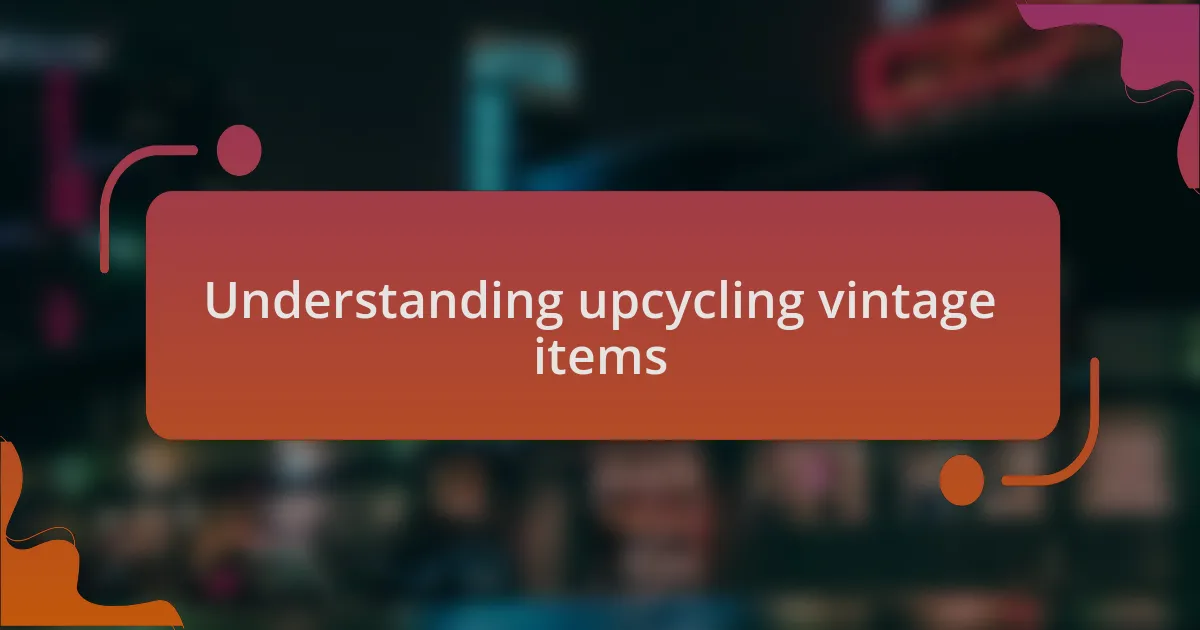
Understanding upcycling vintage items
Upcycling vintage items is all about breathing new life into pieces from the past. I remember finding an old wooden chair at a flea market; it was scruffy and battered but had character. My thoughts were, “How can I make this unique?” That chair now sits in my living room, covered in a vibrant fabric that reflects my style—reminding me that upcycling is about creativity and personal expression.
When I dive into upcycling, I think of it as a conversation between the old and the new. It’s not just about preserving history; it’s about transforming it. I often ask myself, “How can this item tell a different story?” When I took an antique suitcase and turned it into a trendy side table, it sparked discussions with friends and family. It felt rewarding to see their surprise and interest, opening a dialogue about the beauty of vintage items reimagined for modern living.
The emotional connection to upcycled pieces is profound. Each item carries a history that can be reassigned. For instance, when I salvaged a vintage lamp and gave it a fresh coat of paint, it felt like I was sending a personal message to the universe: every object has potential. Have you ever thought about what hidden stories might lie within your vintage finds? Exploring those narratives is what makes upcycling so special and fulfilling.
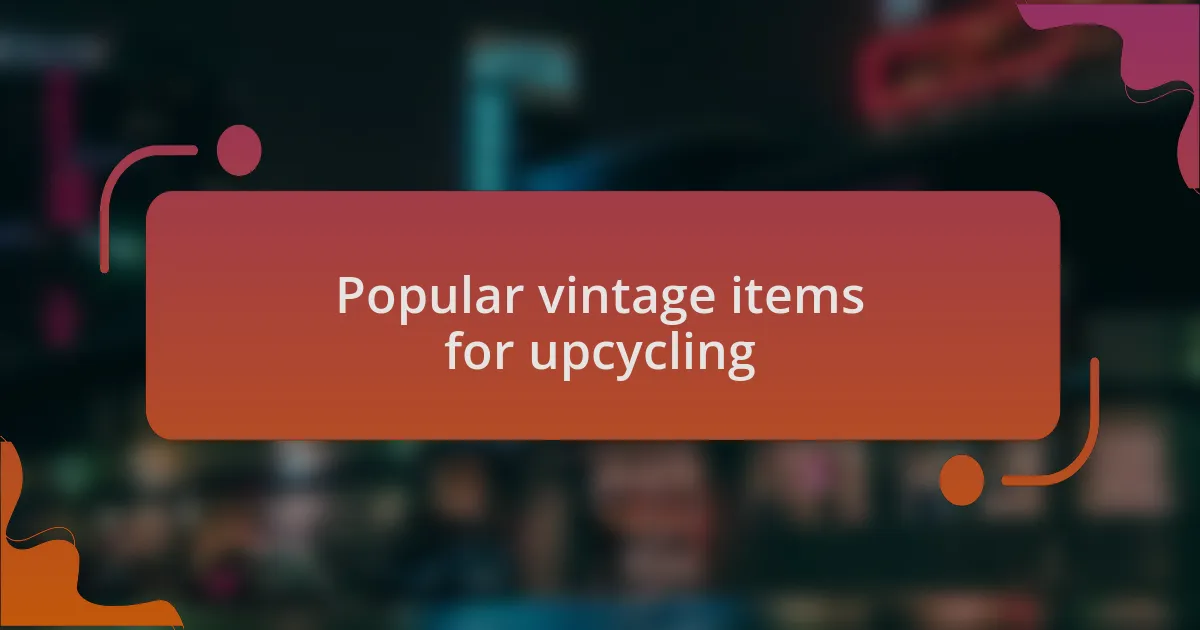
Popular vintage items for upcycling
When it comes to popular vintage items for upcycling, furniture often tops the list. I remember spotting an old dresser at a garage sale; it was covered in paint splatters and had one missing knob. Instead of discarding it, I saw the potential for a chic statement piece. After some sanding and a fresh coat of paint, along with new hardware, it became a stunning addition to my bedroom. Can you imagine the stories that old dresser could tell?
Another item I love to upcycle is vintage glassware. There’s something magical about transforming mismatched glasses into a cohesive set. I once collected various colored jars and turned them into pendant lights for my kitchen. The glow they cast creates such a warm ambiance; it’s hard not to smile every time I walk by. Do you have old glass items tucked away that could shine anew in your home?
And let’s not overlook vintage textiles! A few years back, I stumbled upon a stack of retro tablecloths while thrifting. Rather than letting them gather dust, I decided to use them for cushion covers. The bold patterns add a fun touch to my space and were a conversation starter at a recent gathering. Have you thought about how old fabrics can breathe new life into your decor? The possibilities are endless!
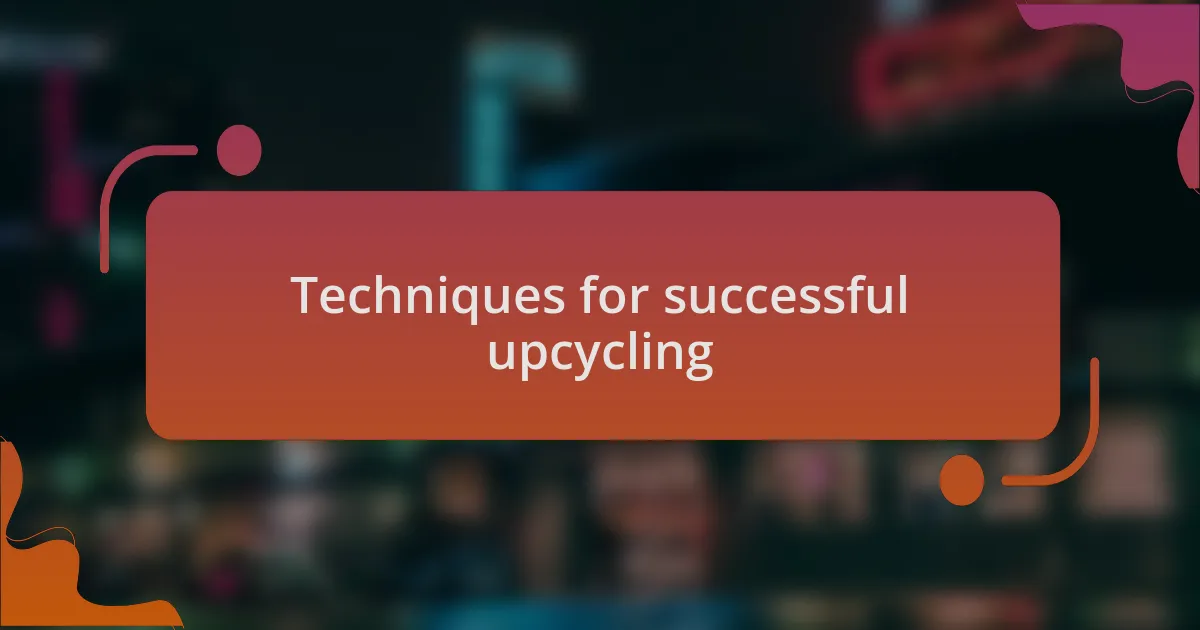
Techniques for successful upcycling
When diving into upcycling, I find it crucial to start with a clear vision. For instance, when I decided to transform an old wooden chair, I imagined it as a vibrant accent in my living room. After some thoughtful planning and sketching, I picked bold colors that perfectly matched my decor, turning a forgotten piece into a trendy statement item. Have you ever visualized a new purpose for something old?
Another technique that has worked wonders for me is combining different materials. One memorable project involved taking vintage fabric scraps and attaching them to a bare wooden shelf. The mix of textures and colors not only added depth but also showcased my personal style. It’s remarkable how layering materials can create a unique piece that reflects who you are. Are there materials around you that could complement each other beautifully?
Lastly, patience is key in the upcycling process. While refinishing an antique trunk, I initially rushed through sanding, only to realize the imperfections were more pronounced. Slowing down allowed me to achieve a smooth finish, and the trunk now serves as a functional coffee table that sparks conversations. I’ve learned that taking your time can lead to truly exceptional results. Have you taken a moment to appreciate the journey rather than just the end product?
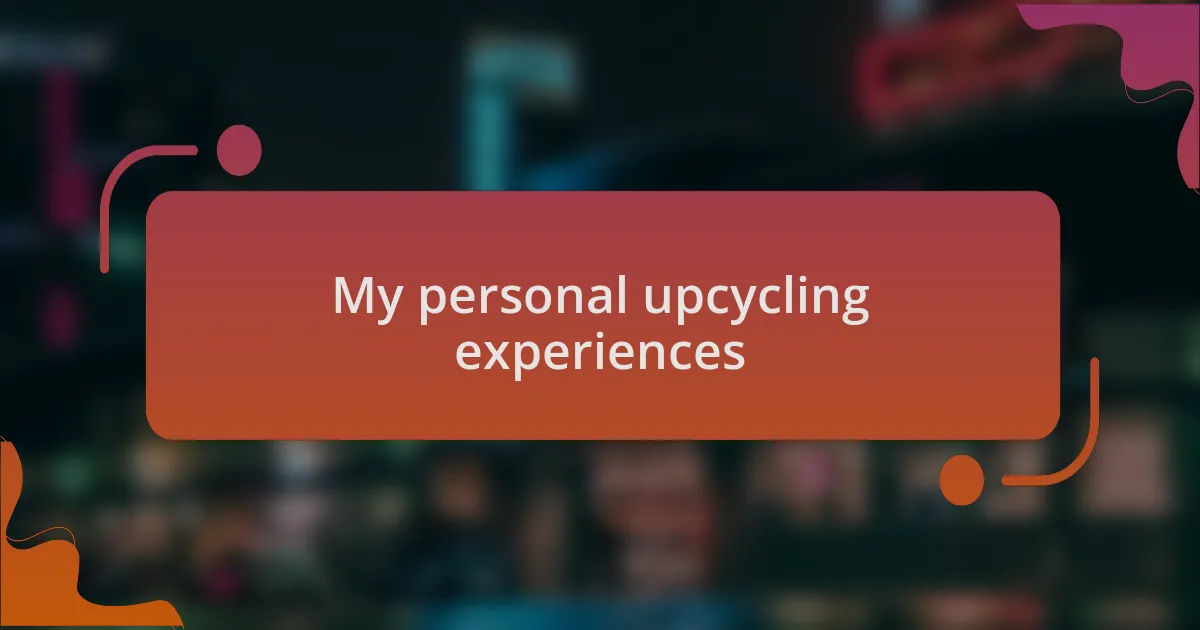
My personal upcycling experiences
My journey into upcycling began with an old, rusty bicycle I found in my grandfather’s shed. I had a burst of inspiration and decided to transform it into a whimsical garden planter. The sight of vibrant flowers cascading from the basket brought me so much joy, and I often find myself smiling whenever I step into the yard. Have you ever turned something rusty and forgotten into a piece of beauty?
Another memorable experience was when I transformed a vintage suitcase into a unique pet bed for my dog. It wasn’t just about practicality; it became a cozy nook that added character to my living space. Every time I see my pup curled up inside, I can’t help but feel proud of how I reshaped an item with history into something my furry friend loves. Isn’t it fascinating how upcycling allows us to create meaningful spaces?
Sometimes, upcycling presents unexpected challenges that ultimately lead to the most rewarding experiences. While working on a set of mismatched vintage plates, I encountered issues with my first attempts at creating a wall display. Instead of giving up, I embraced the imperfections, letting them guide the design to be more eclectic and charming. Now, every guest admires it, and it sparks delightful conversations. Do you think embracing imperfections can lead to unexpected beauty?
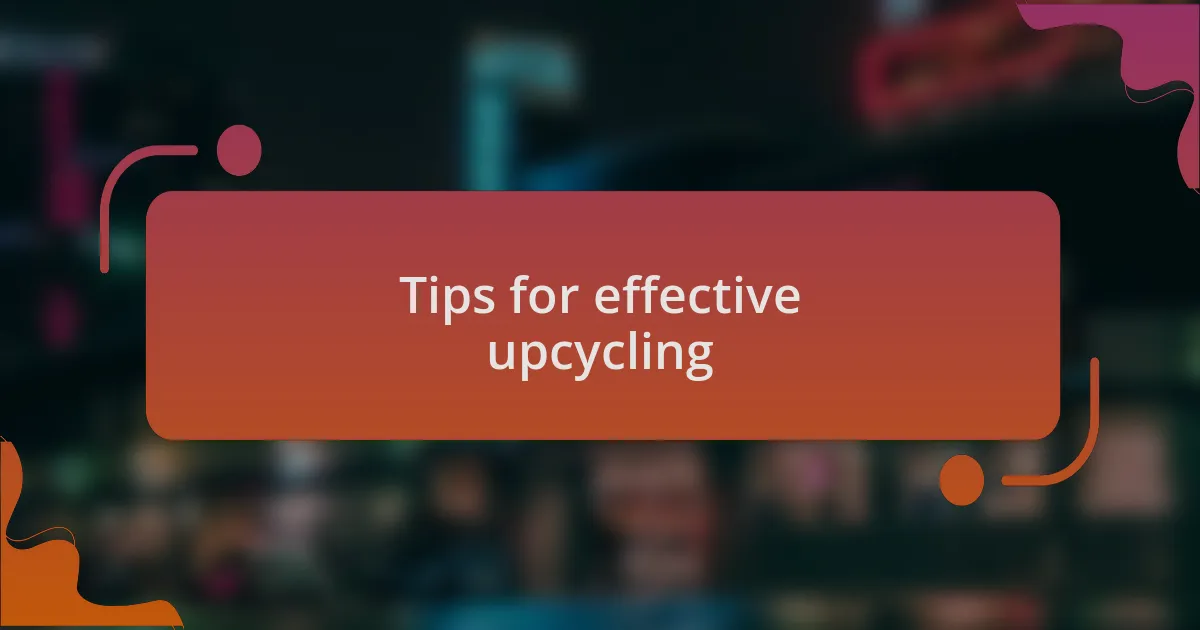
Tips for effective upcycling
When diving into upcycling, it’s essential to start with a clear vision of what you want to create. I remember rummaging through my local thrift shop and spotting an old wooden ladder. Instead of rushing into a project, I took a moment to envision it as a beautiful bookshelf. This simple thought process helped me focus on the potential of the item rather than its current state. Have you ever taken a moment to simply visualize what could be?
Research and planning can transform your upcycling experience. The first time I decided to upcycle a tarnished mirror frame, I learned about paint types that adhere to metal surfaces. With that knowledge in hand, I chose a vibrant color that brought new life to the frame, turning it into a striking centerpiece. It’s remarkable how a little preparation can make your project not only easier but also more enjoyable. What’s one small thing you could learn that might elevate your next upcycling adventure?
One thing I truly value in upcycling is the importance of patience. I once attempted to turn a vintage chair into a statement piece with a bold fabric. The process was not without its frustrations—those stubborn staples were the bane of my existence! But taking my time and working through those moments taught me that good things don’t happen overnight. Do you find that slowing down during a project can sometimes lead to unexpected satisfaction?
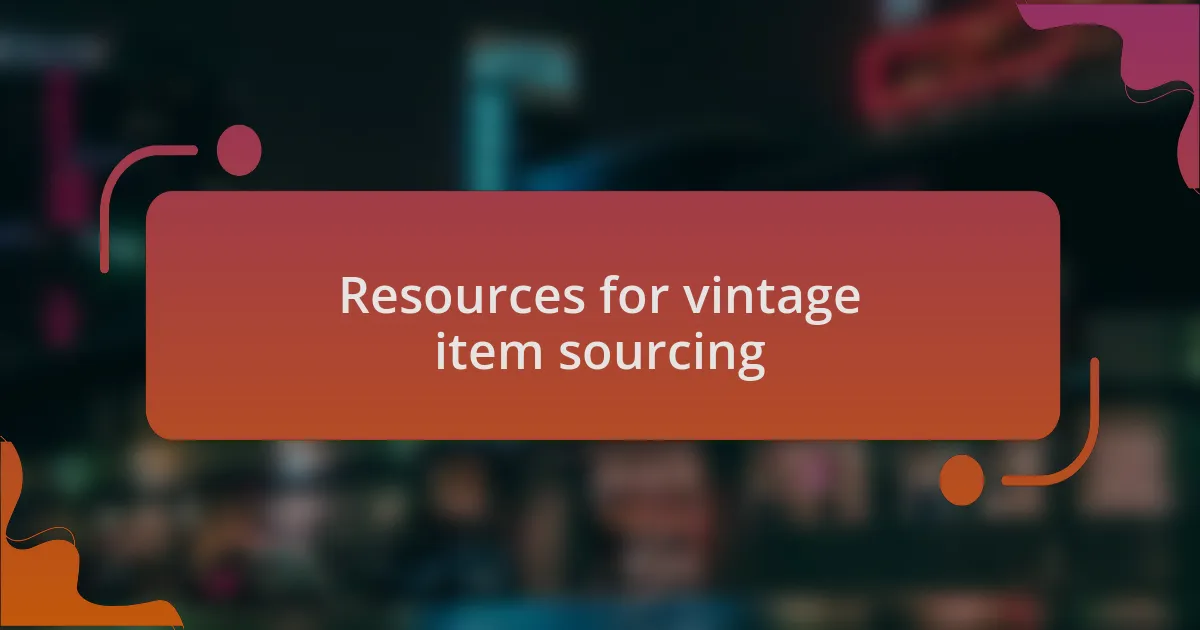
Resources for vintage item sourcing
Finding quality vintage items requires some creativity and persistence. I recall a Saturday morning spent at a flea market where I stumbled upon a stunning mid-century lamp. It wasn’t just luck; I had spent hours researching local markets and learned that Saturdays often draw sellers with unique pieces. Have you ever explored a marketplace and uncovered a hidden gem?
Another great resource is online platforms dedicated to vintage finds. I’ve had incredible success on sites like Etsy and eBay, where you can connect with sellers from around the world. I remember bidding on a set of vintage tea cups that exceeded my expectations when they arrived. The thrill of waiting for a package filled with history can be quite special, don’t you think?
Finally, consider joining local or online vintage enthusiast groups. I joined a Facebook group focused on local vintage finders, which opened doors to exclusive sales and swaps. It’s a fantastic way to receive tips and hear about events you might have otherwise missed. Connecting with others who share your passion can make the sourcing journey even more enriching. What communities have you discovered that spark your interest in vintage collecting?